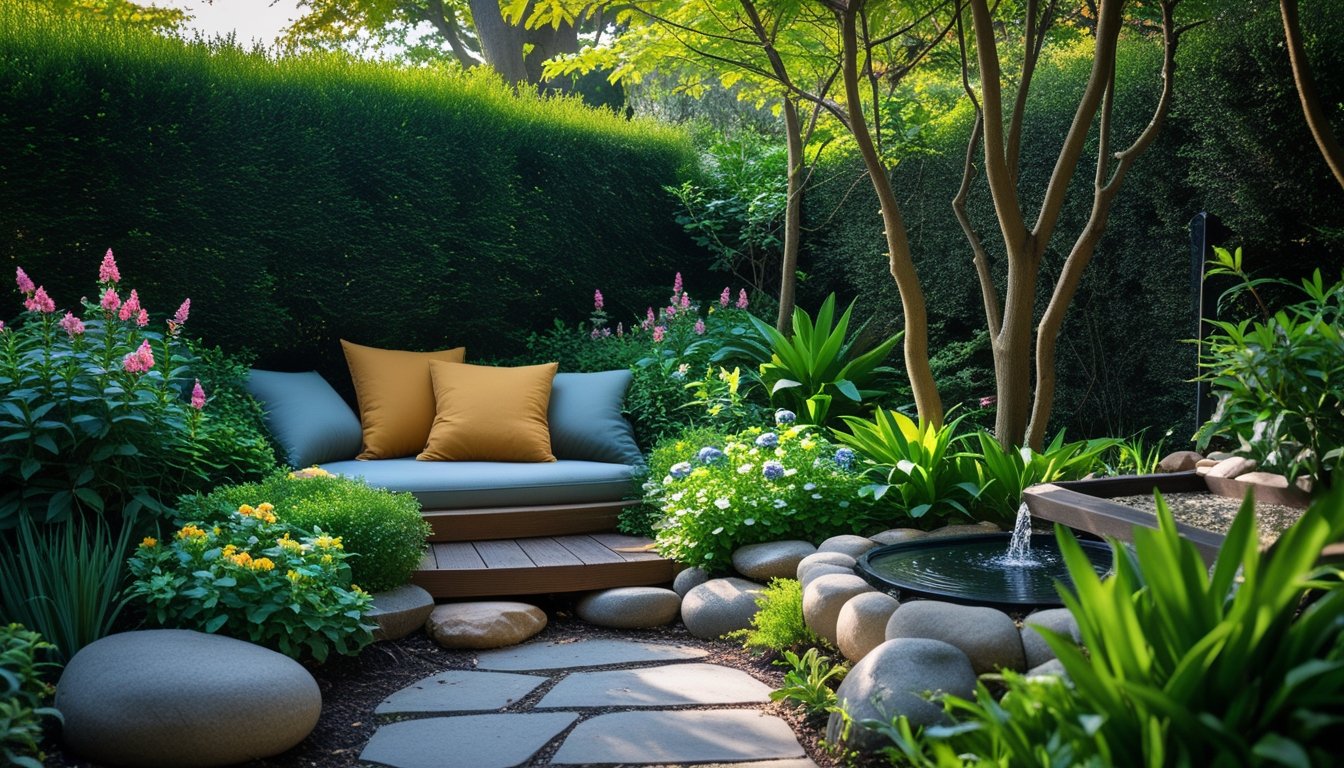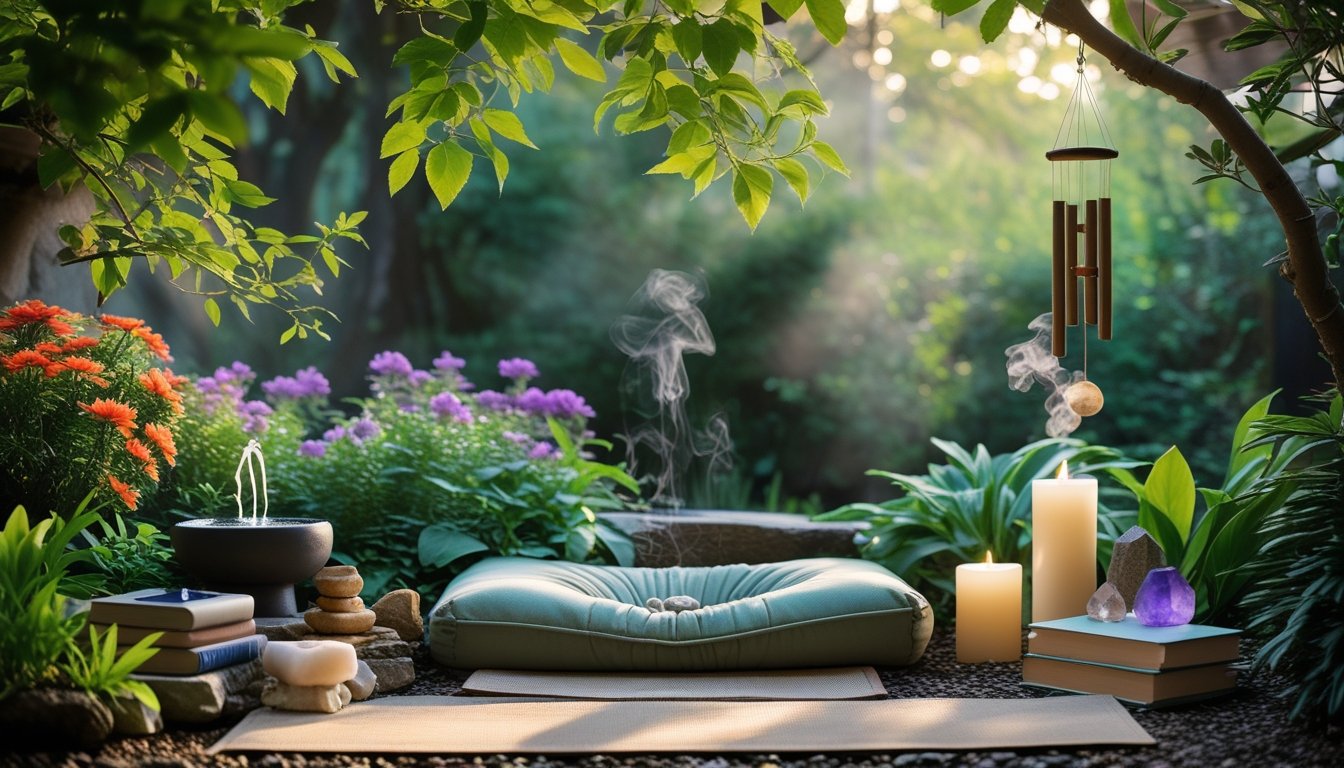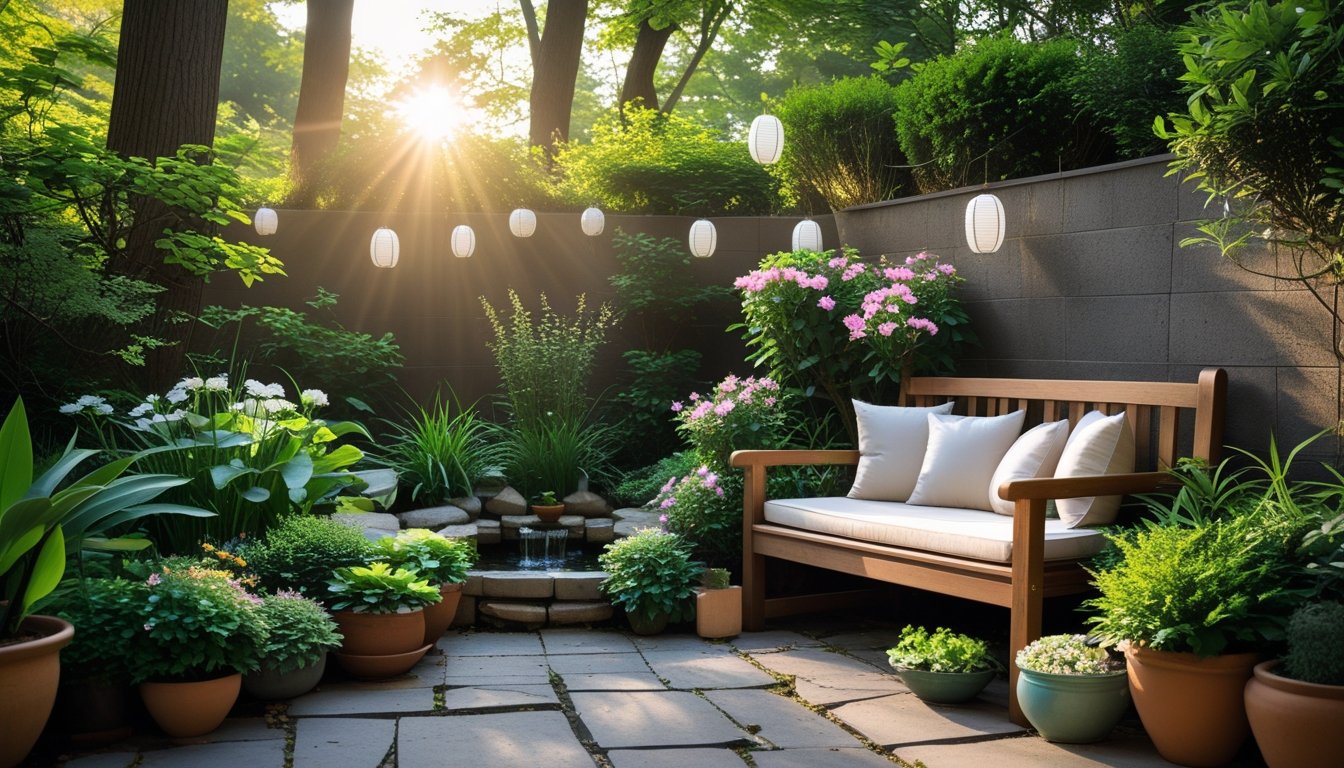Late updated: 08 Sep 2025 10:09
Written by: James Whitaker
Creating A Relaxing Garden Nook For Meditation: Your Tranquil Escape Guide
Creating a quiet and calming space in our gardens can offer a much-needed reprieve from the hustle and bustle of daily life. A well-designed garden nook for meditation not only provides a peaceful sanctuary but also offers a chance for us to connect more deeply with nature. Choosing the right location, designing comfortable seating, and selecting suitable plants are essential steps in creating your own personal retreat.

By thoughtfully selecting elements such as comfortable seating and calming plants, we can transform a simple corner of our garden into a place that nurtures both mind and spirit. Incorporating personal touches and maintaining this special spot enhances its inviting nature, making meditative practice a regular part of our routine. When we engage all our senses with features like aromatic flowers or the gentle gurgle of a water feature, our garden nook becomes a truly tranquil refuge.
Unleashing creativity while planning our meditation space can bring both joy and relaxation. Drawing inspiration from diverse sources allows us to design a nook tailored to our personal preferences and needs. As we incorporate elements like stones, bamboo, and water features, we create not just a garden, but a personal sanctuary offering peace and inspiration.
Key Takeaways
- Design a meditative garden nook by choosing the right location and comfortable seating.
- Enhance your garden nook with sensory and personal touches for a tranquil experience.
- Incorporate elements that engage all senses to create a peaceful sanctuary.
Designing a Relaxing Garden Nook for Meditation
Creating a peaceful retreat in our garden involves thoughtful consideration of location, natural elements, seating, and lighting. Each aspect plays a vital role in crafting a space that nurtures meditation, relaxation, and mindfulness.
Choosing the Ideal Location for Tranquillity
Selecting the right spot for our garden nook is paramount. We should find a quiet corner that offers privacy and minimal disturbances. An area surrounded by natural elements like trees or shrubs can enhance the feeling of seclusion.
In larger gardens, a spot near a stone pathway leading to the nook adds a serene approach. If space is limited, we can craft a nook on a patio with strategic positioning of planters for a sense of enclosure. Proximity to calming elements, such as a pond or water feature, can greatly augment the tranquil atmosphere.
Incorporating Natural Elements for Serenity
Natural elements amplify the calming effect of a meditation space. Incorporating features like zen gardens with raked gravel and strategically placed stones provides a touch of mindfulness and order. Potted plants such as bamboo or lavender add both aesthetic appeal and soothing scents.
A balance of greenery and open space is important for creating harmony. We can use bamboo screens or wooden trellises to define the space without restricting flow. Adding natural textures, like a wooden bench or stone seat, integrates well with the environment, contributing to a cohesive design that promotes well-being.
Selecting Cosy and Comfortable Seating
Comfortable seating is crucial for a space dedicated to meditation. We should choose materials that provide support and comfort. Low benches or cushions designed for outdoor use can create a relaxed seating arrangement.
A mix of hard and soft seating options accommodates different preferences and allows us to shift positions comfortably. Weather-resistant fabrics ensure durability and longevity, while earthy tones and natural materials maintain the aesthetics. Placing the seating to face a focal point, such as a water feature or garden sculpture, encourages a meditative focus.
Setting the Mood with Ambient Lighting
Lighting enhances the ambience of our garden nook, making it inviting both day and night. Soft, ambient lighting, such as solar-powered lanterns or string lights, creates a warm and comforting glow. It's essential to ensure that lighting fixtures are water-resistant and energy-efficient.
Candles or battery-operated LED lights provide a gentle, flickering effect ideal for evening meditation. We might employ spotlights to highlight specific features like a stone pathway or plants, enhancing the garden's visual interest. By layering light levels, we achieve a dynamic atmosphere that adapts to different moods and times of day, adding to the overall sense of relaxation and peace in our sanctuary.
Enhancing Your Meditation Space with Sensory and Personal Touches

Creating a meditative garden requires not only tranquillity but also sensory enrichment and personalisation. By incorporating scents, sounds, sights, and personal elements, we can transform a simple garden into a sanctuary of peace and mindful reflection.
Calming Scents, Aromatic Herbs, and Flower Choices
Aromatic plants can greatly enhance a meditation space. Lavender is well-known for its calming properties, while mint and basil can offer a refreshing and invigorating aroma. Rosemary adds a subtle touch that stimulates clarity and focus. Roses, with their soothing and elegant scent, can lend a romantic atmosphere to your space.
Incense sticks or scented candles are excellent for adding depth to the sensory experience. These can be changed according to mood or the time of day. By experimenting with different scents, we can discover what combinations foster the best meditation sessions. The choice of plants and scents should reflect personal tastes and achieve a balance that invites relaxation.
Water Features, Sound Accents, and Visual Focal Points
Introducing a water feature like a small fountain can provide a soothing soundscape, masking environmental noise. The gentle trickle of water enriches the meditative experience, encouraging focus and relaxation. Wind chimes add an element of random, gentle sound, enhancing concentration through their melodic presence.
Visual focal points such as sculptures or trellises with climbing plants can guide our attention, anchoring our meditation practice. String lights or ambient lighting can create a magical evening atmosphere, allowing us to enjoy the garden both day and night. Choosing focal points thoughtfully will help craft an environment that feels welcoming and serene.
Spiritual Symbols, Decorative Items, and Meaningful Details
The inclusion of spiritual symbols can impart a deeper sense of connection. Statues, crystals, or totems can serve as reminders of personal beliefs or aspirations. Decorative items, such as bird feeders, encourage wildlife, adding a dynamic layer to the garden.
Meaningful details like carefully selected artefacts or mementoes infuse the space with personality. Whether it’s a family heirloom or a piece with special significance, these items can make our meditation area uniquely our own. By personalising the space, we strengthen our connection to it and enrich our meditation journey.
Frequently Asked Questions

In creating a tranquil garden nook for meditation, attention to detail is vital. By thoughtfully incorporating natural elements, plants, and features, we can craft a serene outdoor retreat. Here, we address some common questions to help guide you in designing an inviting meditation space.
What are the essential elements to include in a small meditation garden?
Key components for a small meditation garden include comfortable seating, calming plants, and soothing decor. Selecting elements that resonate with your personal style can greatly enhance the atmosphere. Some prefer a minimalist design, while others might include stones, bamboo screens, or small statuary.
How can I design a meditation garden in a limited outdoor space?
In limited spaces, creativity is essential. Vertical gardens and multi-functional furniture can maximise the use of space. Include pathways using stones or stepping tiles to create a sense of journey, even within a compact area. Emphasize height and layers by incorporating hanging plants or trellises.
Which plants are most suitable for creating a serene meditation garden atmosphere?
Choosing the right plants can greatly influence the garden's mood. Consider including lavender, ferns, or jasmine for their calming properties and pleasant scents. Grasses that sway gently in the breeze can also add to the tranquillity. Native plants can ensure easy maintenance and harmonious integration with the local environment.
What features can enhance the tranquillity of a meditation garden?
Enhance tranquillity with natural features like stone arrangements, wind chimes, or a small pond. Soft lighting using lanterns or solar lights can create a warm glow during evening meditation. Use of natural materials like wood or stone further ties the garden elements together, promoting a coherent and peaceful setting.
How can I incorporate water elements into a meditation garden design?
Water elements such as small fountains or birdbaths can be an excellent addition. The sound of gently flowing water promotes relaxation and masks ambient noise. For small spaces, consider a wall-mounted fountain or a tabletop water feature to maintain the soothing auditory effect without requiring substantial space.
Could you suggest any layouts for a meditation garden plan?
Circular layouts can foster a sense of unity and central focus, ideal for meditation. Alternatively, a Zen-inspired layout incorporating asymmetrical elements might appeal. Incorporate pathways that guide visitors to distinct areas for meditation or introspection. Use natural dividers like hedges or bamboo for privacy, creating an intimate garden experience.
